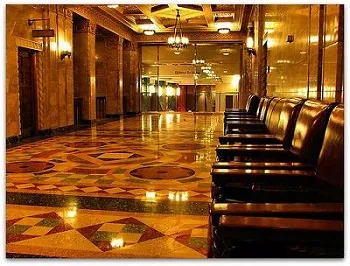Systems & Aesthetics
The Mayo brothers were the first physicians to found a non-profit medical organization, with all excess funds returned to the clinic to promote its growth. They paid medical doctors not a fee for service but a fixed salary at market rates in order to increase their incentive to spend more time with patients. Individual doctors and practice groups were not judged by the revenue they produced; rather the clinic had an integrated system of financial accountability.

Buildings at the Mayo Clinic are connected with underground passages that keep patients and doctors out of the cold.
The Mayo brothers set up a structure in which the business of the clinic was run by a partnership of physicians and administrators. Physicians rotated in and out of leadership positions, so that the financial needs of the business were seen through the eyes of both a doctor and a business expert. The clinic also developed an extensive committee system. Major decisions were made by committees of physicians, who looked after clinical practice, education, research, personnel, finance, and other areas of administration large and small. Any significant new policy had to go through a committee review process, which identified the effects of the decision on other parts of the clinic's operations.
To support the work of the clinic, the Mayo brothers and their colleagues set up a sophisticated infrastructure. They invented the patient medical record to replace ledgers that were kept in each doctor’s office. They established accounting systems, and they set up physical supports, including a power plant, subways, and a pneumatic tube system for the delivery of medical records.
Over the years, Mayo leaders maintained a commitment to the careful design of the health care experience. By the 1980s and 90s, Mayo Clinic was legendary for its scheduling efficiency: patients traveling from faraway locations could have an examination and tests on Monday morning, receive a diagnosis on Monday afternoon, undergo surgery on Tuesday, and go home on Thursday.
Innovation in Aesthetics
From its early days, Mayo Clinic paid attention to the link between wellness and physical surroundings. The Mayo brothers' first building, completed in 1914, featured an elegantly appointed lobby in the style of a grand hotel, and the 1928 Plummer Building was designed in art deco style, with carillon bells that are still played six times a week.

Lobby of the Plummer Building in the Mayo complex.
Later buildings were constructed to include art galleries and lobbies with grand pianos. Benefactors donated chandeliers, sculpture, and other art from around the world. An art committee oversees the development of exhibits and concerts, and regular tours are given focusing on the art and architecture of the clinic.
Today many hospitals have signature buildings adorned with gardens, fountains, and sculptures. But Mayo Clinic was a pioneer in the use of architecture and design to promote the healing of the whole person. “Here science serves, enthroned in architecture and crowned in music,” said former carillonneur Jimmy Drummond.